Accounting Regulations Adjustment, Application, and Effect
VerifiedAdded on 2021/05/31
|9
|2514
|63
Report
AI Summary
This report examines the effects of accounting regulations on financial statements, focusing on the quality characteristics of accounting information, including relevance, faithful representation, and understandability. It discusses the role of corporate social responsibility (CSR) and the impact of government regulations. The report critiques current reporting practices and the motivations behind asset valuation decisions, such as the historical cost method versus fair value, and how these decisions influence financial statement presentation. It also addresses how directors' preferences affect asset revaluation, depreciation, and profit reporting, and the consequences for stakeholders and financial statement accuracy. The analysis covers the interplay between accounting standards (IFRS and US GAAP), asset valuation, and the ethical considerations in financial reporting.
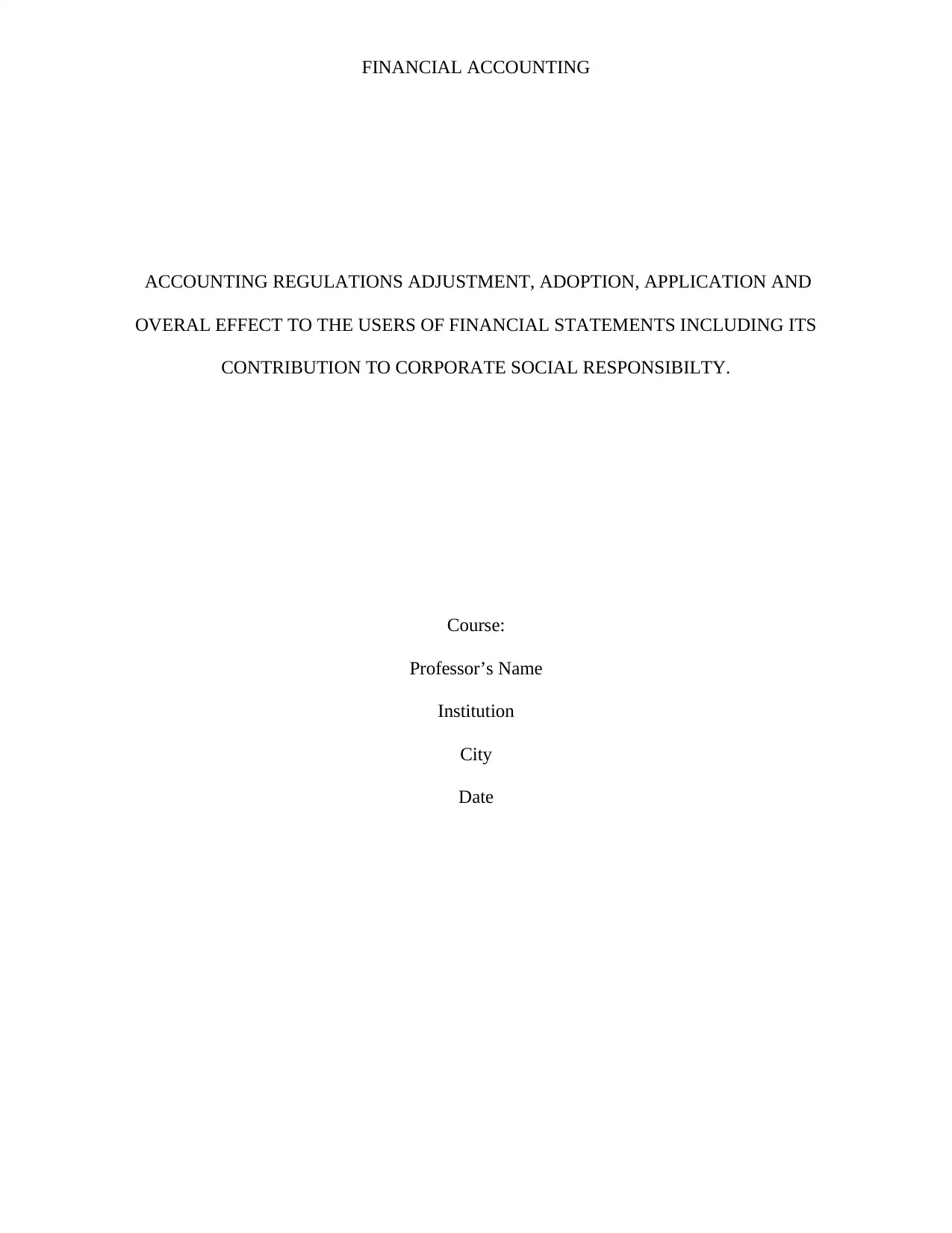
FINANCIAL ACCOUNTING
ACCOUNTING REGULATIONS ADJUSTMENT, ADOPTION, APPLICATION AND
OVERAL EFFECT TO THE USERS OF FINANCIAL STATEMENTS INCLUDING ITS
CONTRIBUTION TO CORPORATE SOCIAL RESPONSIBILTY.
Course:
Professor’s Name
Institution
City
Date
ACCOUNTING REGULATIONS ADJUSTMENT, ADOPTION, APPLICATION AND
OVERAL EFFECT TO THE USERS OF FINANCIAL STATEMENTS INCLUDING ITS
CONTRIBUTION TO CORPORATE SOCIAL RESPONSIBILTY.
Course:
Professor’s Name
Institution
City
Date
Paraphrase This Document
Need a fresh take? Get an instant paraphrase of this document with our AI Paraphraser
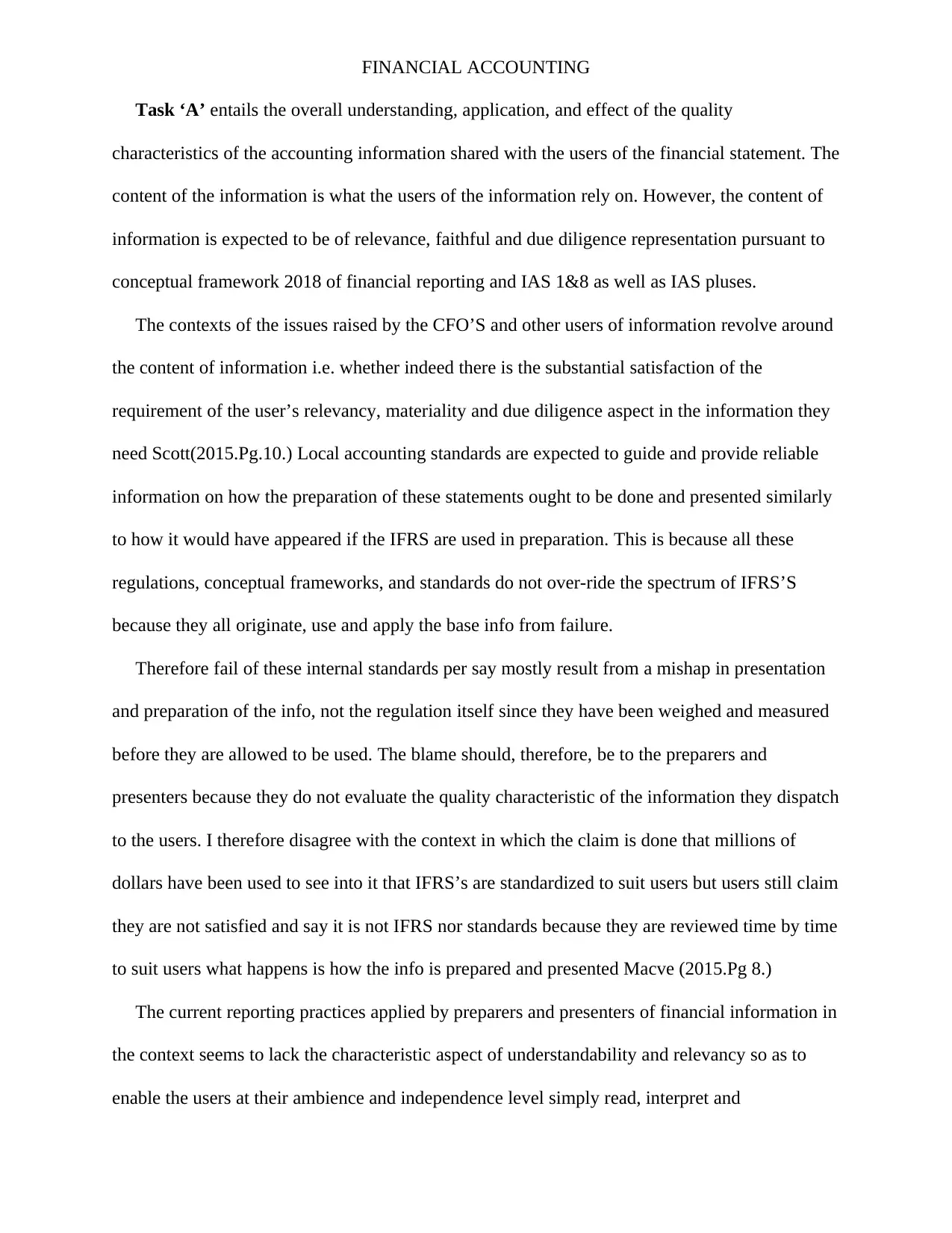
FINANCIAL ACCOUNTING
Task ‘A’ entails the overall understanding, application, and effect of the quality
characteristics of the accounting information shared with the users of the financial statement. The
content of the information is what the users of the information rely on. However, the content of
information is expected to be of relevance, faithful and due diligence representation pursuant to
conceptual framework 2018 of financial reporting and IAS 1&8 as well as IAS pluses.
The contexts of the issues raised by the CFO’S and other users of information revolve around
the content of information i.e. whether indeed there is the substantial satisfaction of the
requirement of the user’s relevancy, materiality and due diligence aspect in the information they
need Scott(2015.Pg.10.) Local accounting standards are expected to guide and provide reliable
information on how the preparation of these statements ought to be done and presented similarly
to how it would have appeared if the IFRS are used in preparation. This is because all these
regulations, conceptual frameworks, and standards do not over-ride the spectrum of IFRS’S
because they all originate, use and apply the base info from failure.
Therefore fail of these internal standards per say mostly result from a mishap in presentation
and preparation of the info, not the regulation itself since they have been weighed and measured
before they are allowed to be used. The blame should, therefore, be to the preparers and
presenters because they do not evaluate the quality characteristic of the information they dispatch
to the users. I therefore disagree with the context in which the claim is done that millions of
dollars have been used to see into it that IFRS’s are standardized to suit users but users still claim
they are not satisfied and say it is not IFRS nor standards because they are reviewed time by time
to suit users what happens is how the info is prepared and presented Macve (2015.Pg 8.)
The current reporting practices applied by preparers and presenters of financial information in
the context seems to lack the characteristic aspect of understandability and relevancy so as to
enable the users at their ambience and independence level simply read, interpret and
Task ‘A’ entails the overall understanding, application, and effect of the quality
characteristics of the accounting information shared with the users of the financial statement. The
content of the information is what the users of the information rely on. However, the content of
information is expected to be of relevance, faithful and due diligence representation pursuant to
conceptual framework 2018 of financial reporting and IAS 1&8 as well as IAS pluses.
The contexts of the issues raised by the CFO’S and other users of information revolve around
the content of information i.e. whether indeed there is the substantial satisfaction of the
requirement of the user’s relevancy, materiality and due diligence aspect in the information they
need Scott(2015.Pg.10.) Local accounting standards are expected to guide and provide reliable
information on how the preparation of these statements ought to be done and presented similarly
to how it would have appeared if the IFRS are used in preparation. This is because all these
regulations, conceptual frameworks, and standards do not over-ride the spectrum of IFRS’S
because they all originate, use and apply the base info from failure.
Therefore fail of these internal standards per say mostly result from a mishap in presentation
and preparation of the info, not the regulation itself since they have been weighed and measured
before they are allowed to be used. The blame should, therefore, be to the preparers and
presenters because they do not evaluate the quality characteristic of the information they dispatch
to the users. I therefore disagree with the context in which the claim is done that millions of
dollars have been used to see into it that IFRS’s are standardized to suit users but users still claim
they are not satisfied and say it is not IFRS nor standards because they are reviewed time by time
to suit users what happens is how the info is prepared and presented Macve (2015.Pg 8.)
The current reporting practices applied by preparers and presenters of financial information in
the context seems to lack the characteristic aspect of understandability and relevancy so as to
enable the users at their ambience and independence level simply read, interpret and
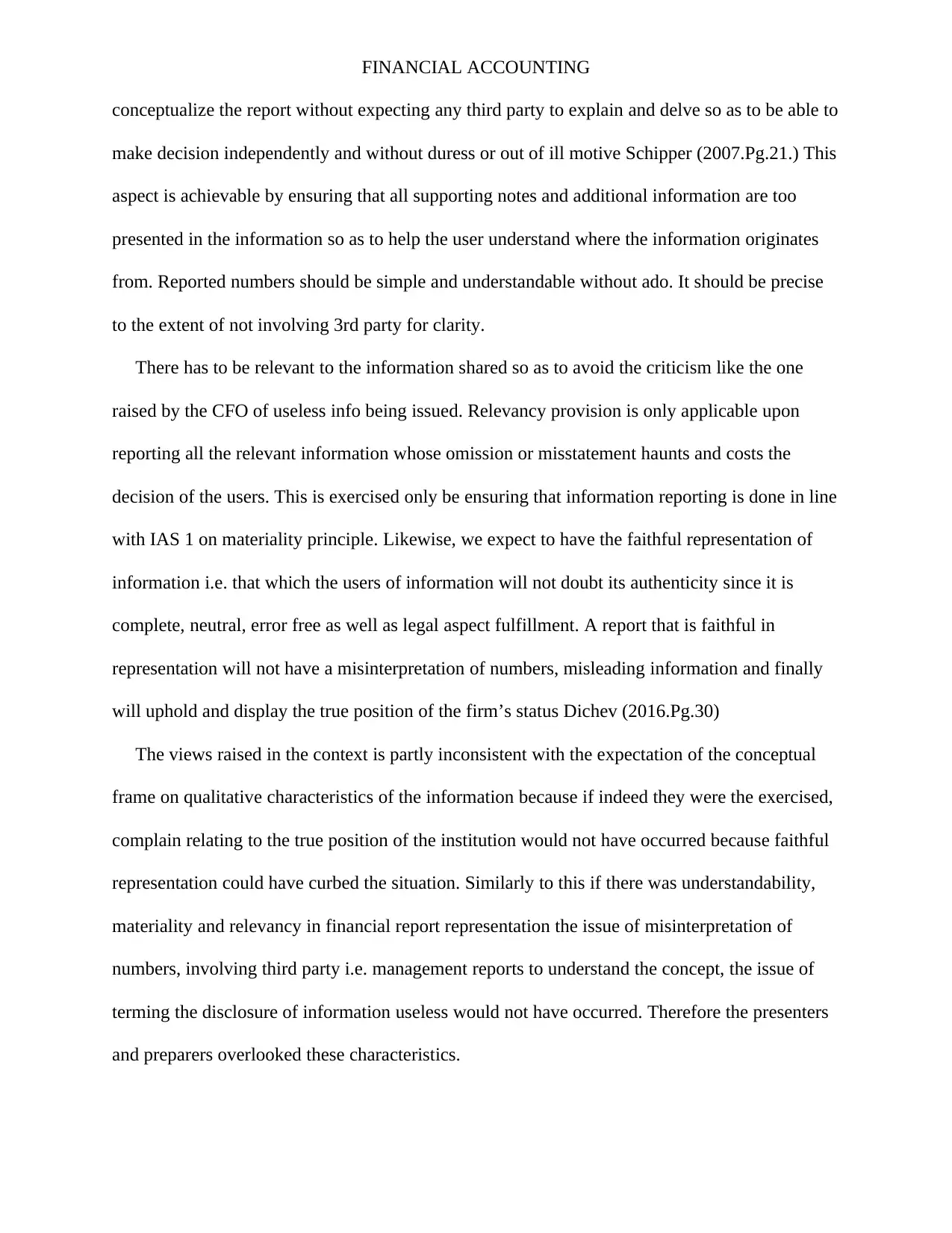
FINANCIAL ACCOUNTING
conceptualize the report without expecting any third party to explain and delve so as to be able to
make decision independently and without duress or out of ill motive Schipper (2007.Pg.21.) This
aspect is achievable by ensuring that all supporting notes and additional information are too
presented in the information so as to help the user understand where the information originates
from. Reported numbers should be simple and understandable without ado. It should be precise
to the extent of not involving 3rd party for clarity.
There has to be relevant to the information shared so as to avoid the criticism like the one
raised by the CFO of useless info being issued. Relevancy provision is only applicable upon
reporting all the relevant information whose omission or misstatement haunts and costs the
decision of the users. This is exercised only be ensuring that information reporting is done in line
with IAS 1 on materiality principle. Likewise, we expect to have the faithful representation of
information i.e. that which the users of information will not doubt its authenticity since it is
complete, neutral, error free as well as legal aspect fulfillment. A report that is faithful in
representation will not have a misinterpretation of numbers, misleading information and finally
will uphold and display the true position of the firm’s status Dichev (2016.Pg.30)
The views raised in the context is partly inconsistent with the expectation of the conceptual
frame on qualitative characteristics of the information because if indeed they were the exercised,
complain relating to the true position of the institution would not have occurred because faithful
representation could have curbed the situation. Similarly to this if there was understandability,
materiality and relevancy in financial report representation the issue of misinterpretation of
numbers, involving third party i.e. management reports to understand the concept, the issue of
terming the disclosure of information useless would not have occurred. Therefore the presenters
and preparers overlooked these characteristics.
conceptualize the report without expecting any third party to explain and delve so as to be able to
make decision independently and without duress or out of ill motive Schipper (2007.Pg.21.) This
aspect is achievable by ensuring that all supporting notes and additional information are too
presented in the information so as to help the user understand where the information originates
from. Reported numbers should be simple and understandable without ado. It should be precise
to the extent of not involving 3rd party for clarity.
There has to be relevant to the information shared so as to avoid the criticism like the one
raised by the CFO of useless info being issued. Relevancy provision is only applicable upon
reporting all the relevant information whose omission or misstatement haunts and costs the
decision of the users. This is exercised only be ensuring that information reporting is done in line
with IAS 1 on materiality principle. Likewise, we expect to have the faithful representation of
information i.e. that which the users of information will not doubt its authenticity since it is
complete, neutral, error free as well as legal aspect fulfillment. A report that is faithful in
representation will not have a misinterpretation of numbers, misleading information and finally
will uphold and display the true position of the firm’s status Dichev (2016.Pg.30)
The views raised in the context is partly inconsistent with the expectation of the conceptual
frame on qualitative characteristics of the information because if indeed they were the exercised,
complain relating to the true position of the institution would not have occurred because faithful
representation could have curbed the situation. Similarly to this if there was understandability,
materiality and relevancy in financial report representation the issue of misinterpretation of
numbers, involving third party i.e. management reports to understand the concept, the issue of
terming the disclosure of information useless would not have occurred. Therefore the presenters
and preparers overlooked these characteristics.
⊘ This is a preview!⊘
Do you want full access?
Subscribe today to unlock all pages.

Trusted by 1+ million students worldwide
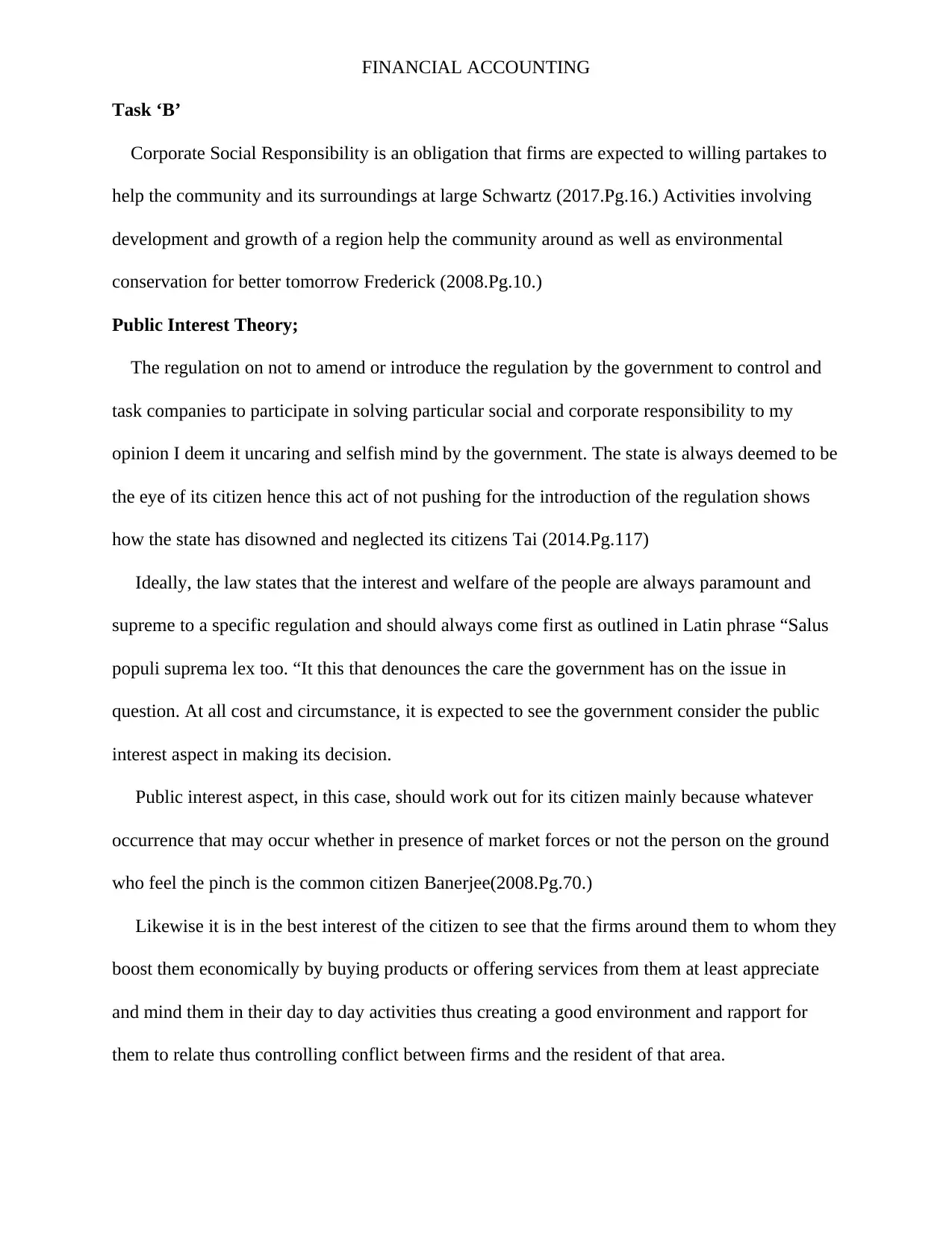
FINANCIAL ACCOUNTING
Task ‘B’
Corporate Social Responsibility is an obligation that firms are expected to willing partakes to
help the community and its surroundings at large Schwartz (2017.Pg.16.) Activities involving
development and growth of a region help the community around as well as environmental
conservation for better tomorrow Frederick (2008.Pg.10.)
Public Interest Theory;
The regulation on not to amend or introduce the regulation by the government to control and
task companies to participate in solving particular social and corporate responsibility to my
opinion I deem it uncaring and selfish mind by the government. The state is always deemed to be
the eye of its citizen hence this act of not pushing for the introduction of the regulation shows
how the state has disowned and neglected its citizens Tai (2014.Pg.117)
Ideally, the law states that the interest and welfare of the people are always paramount and
supreme to a specific regulation and should always come first as outlined in Latin phrase “Salus
populi suprema lex too. “It this that denounces the care the government has on the issue in
question. At all cost and circumstance, it is expected to see the government consider the public
interest aspect in making its decision.
Public interest aspect, in this case, should work out for its citizen mainly because whatever
occurrence that may occur whether in presence of market forces or not the person on the ground
who feel the pinch is the common citizen Banerjee(2008.Pg.70.)
Likewise it is in the best interest of the citizen to see that the firms around them to whom they
boost them economically by buying products or offering services from them at least appreciate
and mind them in their day to day activities thus creating a good environment and rapport for
them to relate thus controlling conflict between firms and the resident of that area.
Task ‘B’
Corporate Social Responsibility is an obligation that firms are expected to willing partakes to
help the community and its surroundings at large Schwartz (2017.Pg.16.) Activities involving
development and growth of a region help the community around as well as environmental
conservation for better tomorrow Frederick (2008.Pg.10.)
Public Interest Theory;
The regulation on not to amend or introduce the regulation by the government to control and
task companies to participate in solving particular social and corporate responsibility to my
opinion I deem it uncaring and selfish mind by the government. The state is always deemed to be
the eye of its citizen hence this act of not pushing for the introduction of the regulation shows
how the state has disowned and neglected its citizens Tai (2014.Pg.117)
Ideally, the law states that the interest and welfare of the people are always paramount and
supreme to a specific regulation and should always come first as outlined in Latin phrase “Salus
populi suprema lex too. “It this that denounces the care the government has on the issue in
question. At all cost and circumstance, it is expected to see the government consider the public
interest aspect in making its decision.
Public interest aspect, in this case, should work out for its citizen mainly because whatever
occurrence that may occur whether in presence of market forces or not the person on the ground
who feel the pinch is the common citizen Banerjee(2008.Pg.70.)
Likewise it is in the best interest of the citizen to see that the firms around them to whom they
boost them economically by buying products or offering services from them at least appreciate
and mind them in their day to day activities thus creating a good environment and rapport for
them to relate thus controlling conflict between firms and the resident of that area.
Paraphrase This Document
Need a fresh take? Get an instant paraphrase of this document with our AI Paraphraser
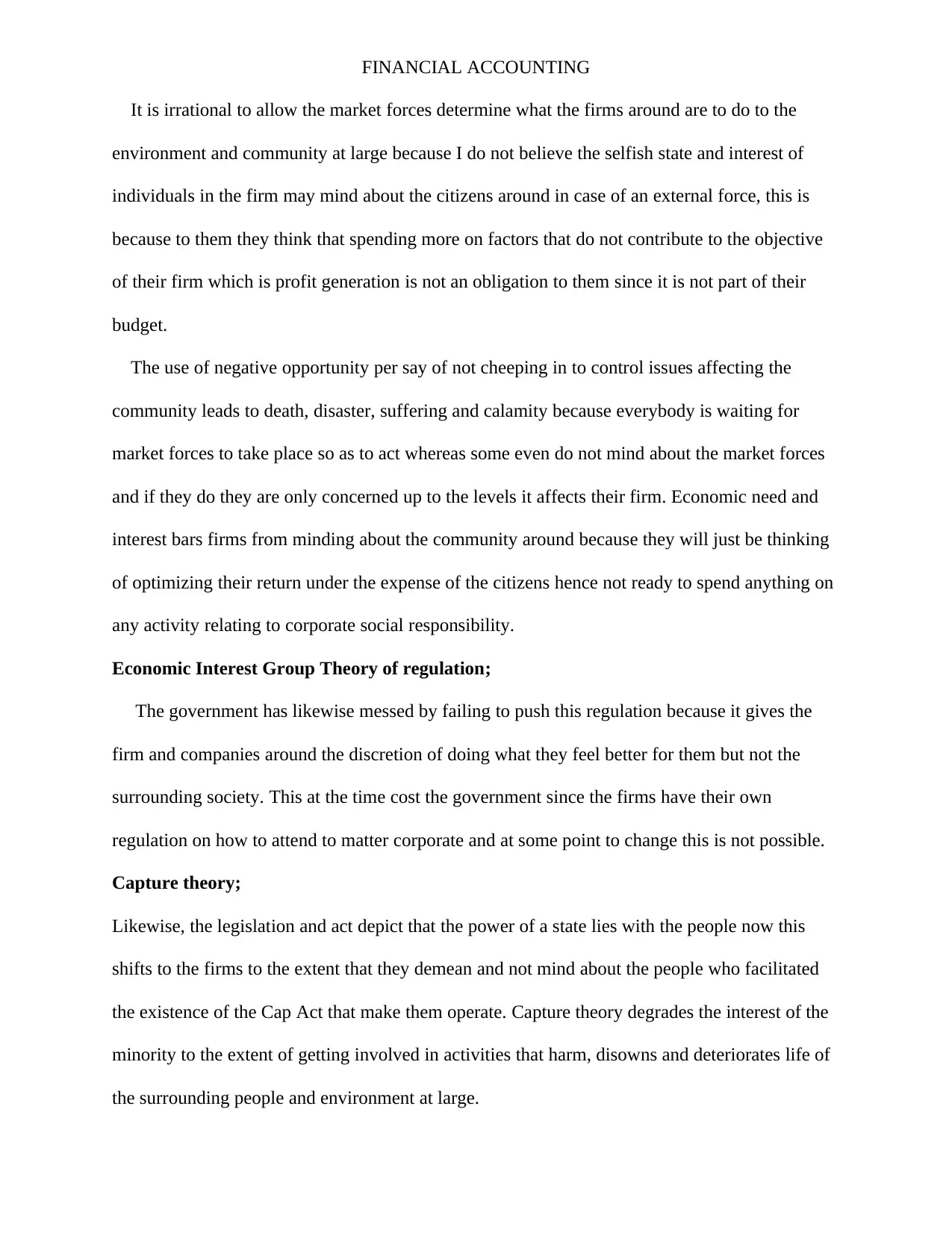
FINANCIAL ACCOUNTING
It is irrational to allow the market forces determine what the firms around are to do to the
environment and community at large because I do not believe the selfish state and interest of
individuals in the firm may mind about the citizens around in case of an external force, this is
because to them they think that spending more on factors that do not contribute to the objective
of their firm which is profit generation is not an obligation to them since it is not part of their
budget.
The use of negative opportunity per say of not cheeping in to control issues affecting the
community leads to death, disaster, suffering and calamity because everybody is waiting for
market forces to take place so as to act whereas some even do not mind about the market forces
and if they do they are only concerned up to the levels it affects their firm. Economic need and
interest bars firms from minding about the community around because they will just be thinking
of optimizing their return under the expense of the citizens hence not ready to spend anything on
any activity relating to corporate social responsibility.
Economic Interest Group Theory of regulation;
The government has likewise messed by failing to push this regulation because it gives the
firm and companies around the discretion of doing what they feel better for them but not the
surrounding society. This at the time cost the government since the firms have their own
regulation on how to attend to matter corporate and at some point to change this is not possible.
Capture theory;
Likewise, the legislation and act depict that the power of a state lies with the people now this
shifts to the firms to the extent that they demean and not mind about the people who facilitated
the existence of the Cap Act that make them operate. Capture theory degrades the interest of the
minority to the extent of getting involved in activities that harm, disowns and deteriorates life of
the surrounding people and environment at large.
It is irrational to allow the market forces determine what the firms around are to do to the
environment and community at large because I do not believe the selfish state and interest of
individuals in the firm may mind about the citizens around in case of an external force, this is
because to them they think that spending more on factors that do not contribute to the objective
of their firm which is profit generation is not an obligation to them since it is not part of their
budget.
The use of negative opportunity per say of not cheeping in to control issues affecting the
community leads to death, disaster, suffering and calamity because everybody is waiting for
market forces to take place so as to act whereas some even do not mind about the market forces
and if they do they are only concerned up to the levels it affects their firm. Economic need and
interest bars firms from minding about the community around because they will just be thinking
of optimizing their return under the expense of the citizens hence not ready to spend anything on
any activity relating to corporate social responsibility.
Economic Interest Group Theory of regulation;
The government has likewise messed by failing to push this regulation because it gives the
firm and companies around the discretion of doing what they feel better for them but not the
surrounding society. This at the time cost the government since the firms have their own
regulation on how to attend to matter corporate and at some point to change this is not possible.
Capture theory;
Likewise, the legislation and act depict that the power of a state lies with the people now this
shifts to the firms to the extent that they demean and not mind about the people who facilitated
the existence of the Cap Act that make them operate. Capture theory degrades the interest of the
minority to the extent of getting involved in activities that harm, disowns and deteriorates life of
the surrounding people and environment at large.
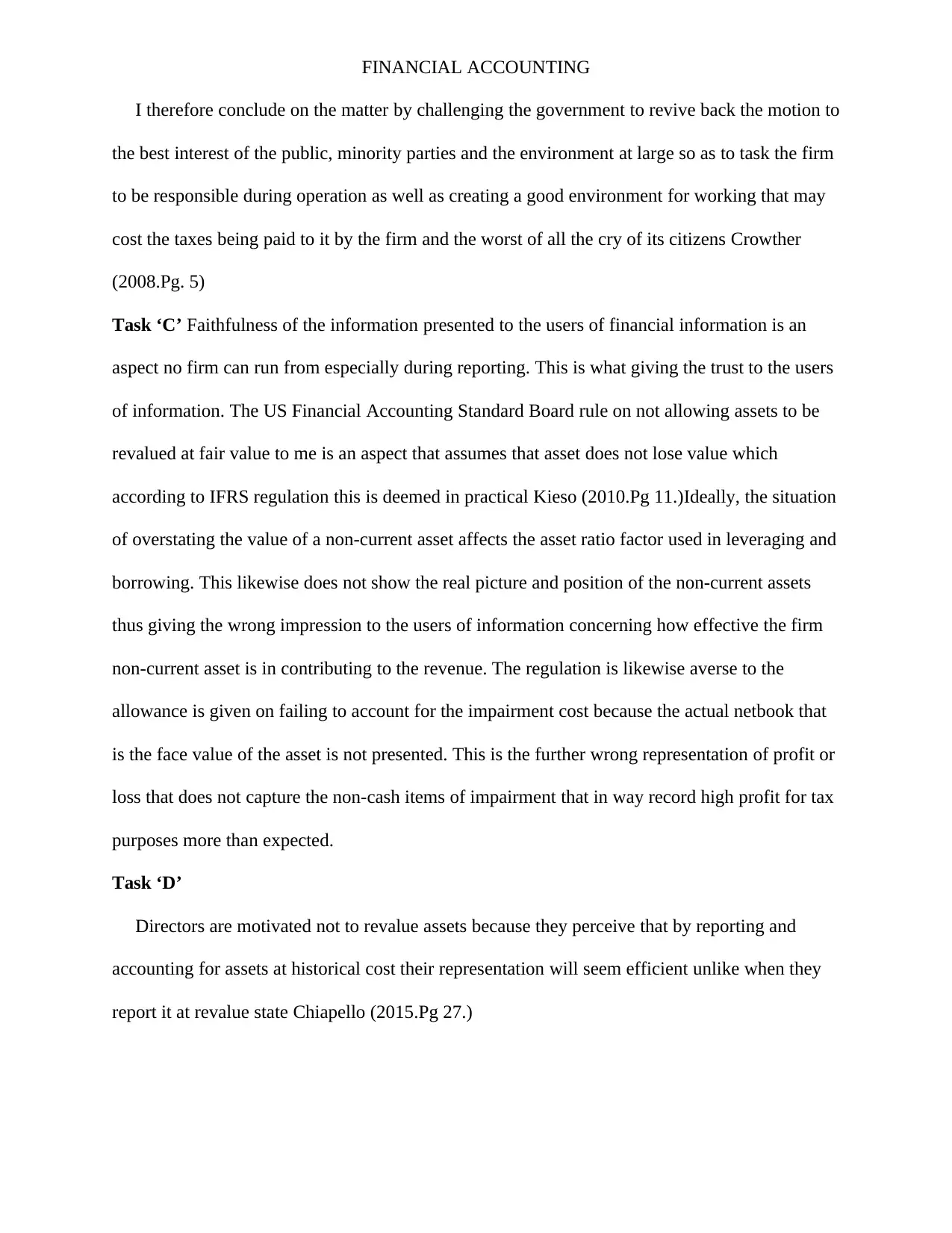
FINANCIAL ACCOUNTING
I therefore conclude on the matter by challenging the government to revive back the motion to
the best interest of the public, minority parties and the environment at large so as to task the firm
to be responsible during operation as well as creating a good environment for working that may
cost the taxes being paid to it by the firm and the worst of all the cry of its citizens Crowther
(2008.Pg. 5)
Task ‘C’ Faithfulness of the information presented to the users of financial information is an
aspect no firm can run from especially during reporting. This is what giving the trust to the users
of information. The US Financial Accounting Standard Board rule on not allowing assets to be
revalued at fair value to me is an aspect that assumes that asset does not lose value which
according to IFRS regulation this is deemed in practical Kieso (2010.Pg 11.)Ideally, the situation
of overstating the value of a non-current asset affects the asset ratio factor used in leveraging and
borrowing. This likewise does not show the real picture and position of the non-current assets
thus giving the wrong impression to the users of information concerning how effective the firm
non-current asset is in contributing to the revenue. The regulation is likewise averse to the
allowance is given on failing to account for the impairment cost because the actual netbook that
is the face value of the asset is not presented. This is the further wrong representation of profit or
loss that does not capture the non-cash items of impairment that in way record high profit for tax
purposes more than expected.
Task ‘D’
Directors are motivated not to revalue assets because they perceive that by reporting and
accounting for assets at historical cost their representation will seem efficient unlike when they
report it at revalue state Chiapello (2015.Pg 27.)
I therefore conclude on the matter by challenging the government to revive back the motion to
the best interest of the public, minority parties and the environment at large so as to task the firm
to be responsible during operation as well as creating a good environment for working that may
cost the taxes being paid to it by the firm and the worst of all the cry of its citizens Crowther
(2008.Pg. 5)
Task ‘C’ Faithfulness of the information presented to the users of financial information is an
aspect no firm can run from especially during reporting. This is what giving the trust to the users
of information. The US Financial Accounting Standard Board rule on not allowing assets to be
revalued at fair value to me is an aspect that assumes that asset does not lose value which
according to IFRS regulation this is deemed in practical Kieso (2010.Pg 11.)Ideally, the situation
of overstating the value of a non-current asset affects the asset ratio factor used in leveraging and
borrowing. This likewise does not show the real picture and position of the non-current assets
thus giving the wrong impression to the users of information concerning how effective the firm
non-current asset is in contributing to the revenue. The regulation is likewise averse to the
allowance is given on failing to account for the impairment cost because the actual netbook that
is the face value of the asset is not presented. This is the further wrong representation of profit or
loss that does not capture the non-cash items of impairment that in way record high profit for tax
purposes more than expected.
Task ‘D’
Directors are motivated not to revalue assets because they perceive that by reporting and
accounting for assets at historical cost their representation will seem efficient unlike when they
report it at revalue state Chiapello (2015.Pg 27.)
⊘ This is a preview!⊘
Do you want full access?
Subscribe today to unlock all pages.

Trusted by 1+ million students worldwide
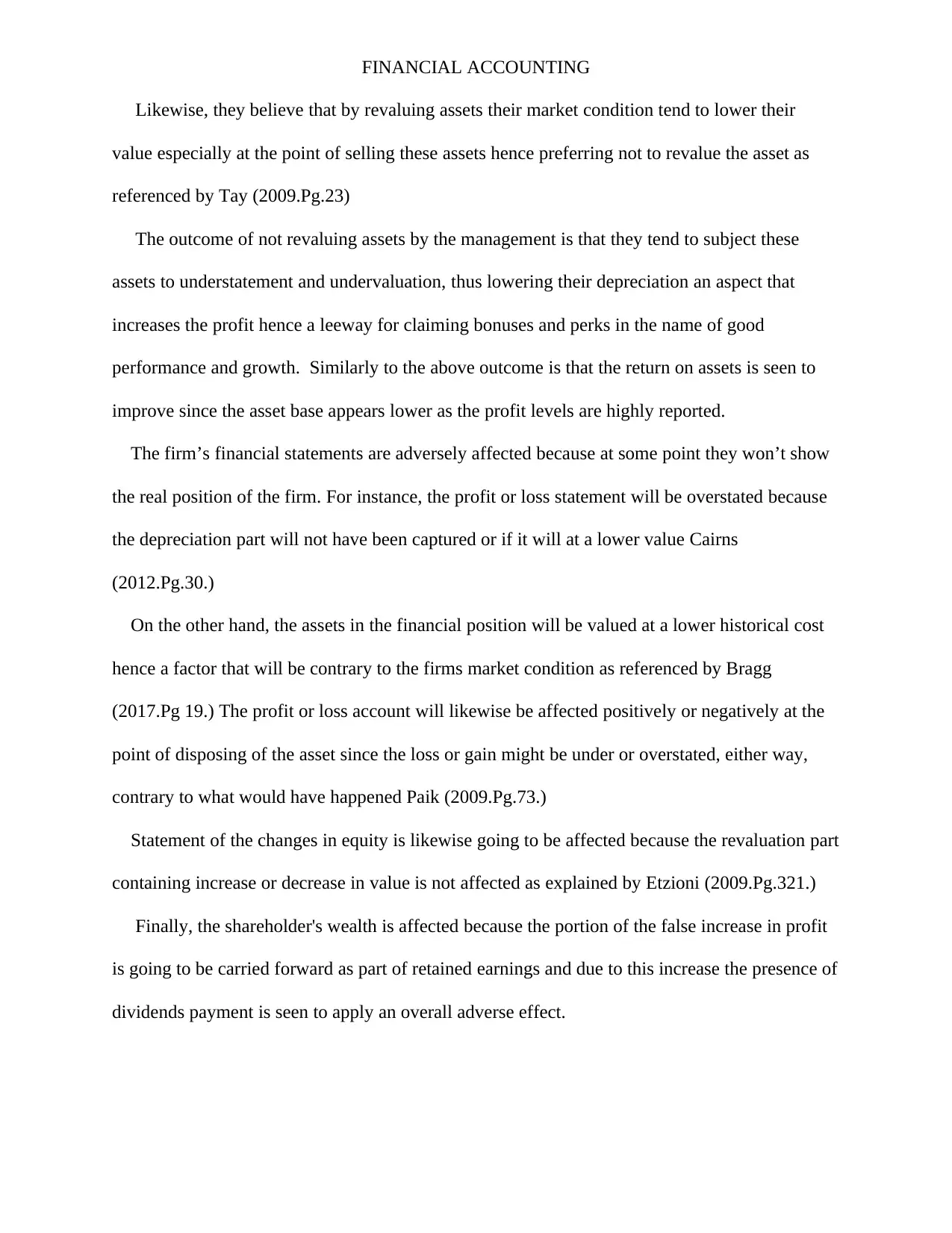
FINANCIAL ACCOUNTING
Likewise, they believe that by revaluing assets their market condition tend to lower their
value especially at the point of selling these assets hence preferring not to revalue the asset as
referenced by Tay (2009.Pg.23)
The outcome of not revaluing assets by the management is that they tend to subject these
assets to understatement and undervaluation, thus lowering their depreciation an aspect that
increases the profit hence a leeway for claiming bonuses and perks in the name of good
performance and growth. Similarly to the above outcome is that the return on assets is seen to
improve since the asset base appears lower as the profit levels are highly reported.
The firm’s financial statements are adversely affected because at some point they won’t show
the real position of the firm. For instance, the profit or loss statement will be overstated because
the depreciation part will not have been captured or if it will at a lower value Cairns
(2012.Pg.30.)
On the other hand, the assets in the financial position will be valued at a lower historical cost
hence a factor that will be contrary to the firms market condition as referenced by Bragg
(2017.Pg 19.) The profit or loss account will likewise be affected positively or negatively at the
point of disposing of the asset since the loss or gain might be under or overstated, either way,
contrary to what would have happened Paik (2009.Pg.73.)
Statement of the changes in equity is likewise going to be affected because the revaluation part
containing increase or decrease in value is not affected as explained by Etzioni (2009.Pg.321.)
Finally, the shareholder's wealth is affected because the portion of the false increase in profit
is going to be carried forward as part of retained earnings and due to this increase the presence of
dividends payment is seen to apply an overall adverse effect.
Likewise, they believe that by revaluing assets their market condition tend to lower their
value especially at the point of selling these assets hence preferring not to revalue the asset as
referenced by Tay (2009.Pg.23)
The outcome of not revaluing assets by the management is that they tend to subject these
assets to understatement and undervaluation, thus lowering their depreciation an aspect that
increases the profit hence a leeway for claiming bonuses and perks in the name of good
performance and growth. Similarly to the above outcome is that the return on assets is seen to
improve since the asset base appears lower as the profit levels are highly reported.
The firm’s financial statements are adversely affected because at some point they won’t show
the real position of the firm. For instance, the profit or loss statement will be overstated because
the depreciation part will not have been captured or if it will at a lower value Cairns
(2012.Pg.30.)
On the other hand, the assets in the financial position will be valued at a lower historical cost
hence a factor that will be contrary to the firms market condition as referenced by Bragg
(2017.Pg 19.) The profit or loss account will likewise be affected positively or negatively at the
point of disposing of the asset since the loss or gain might be under or overstated, either way,
contrary to what would have happened Paik (2009.Pg.73.)
Statement of the changes in equity is likewise going to be affected because the revaluation part
containing increase or decrease in value is not affected as explained by Etzioni (2009.Pg.321.)
Finally, the shareholder's wealth is affected because the portion of the false increase in profit
is going to be carried forward as part of retained earnings and due to this increase the presence of
dividends payment is seen to apply an overall adverse effect.
Paraphrase This Document
Need a fresh take? Get an instant paraphrase of this document with our AI Paraphraser
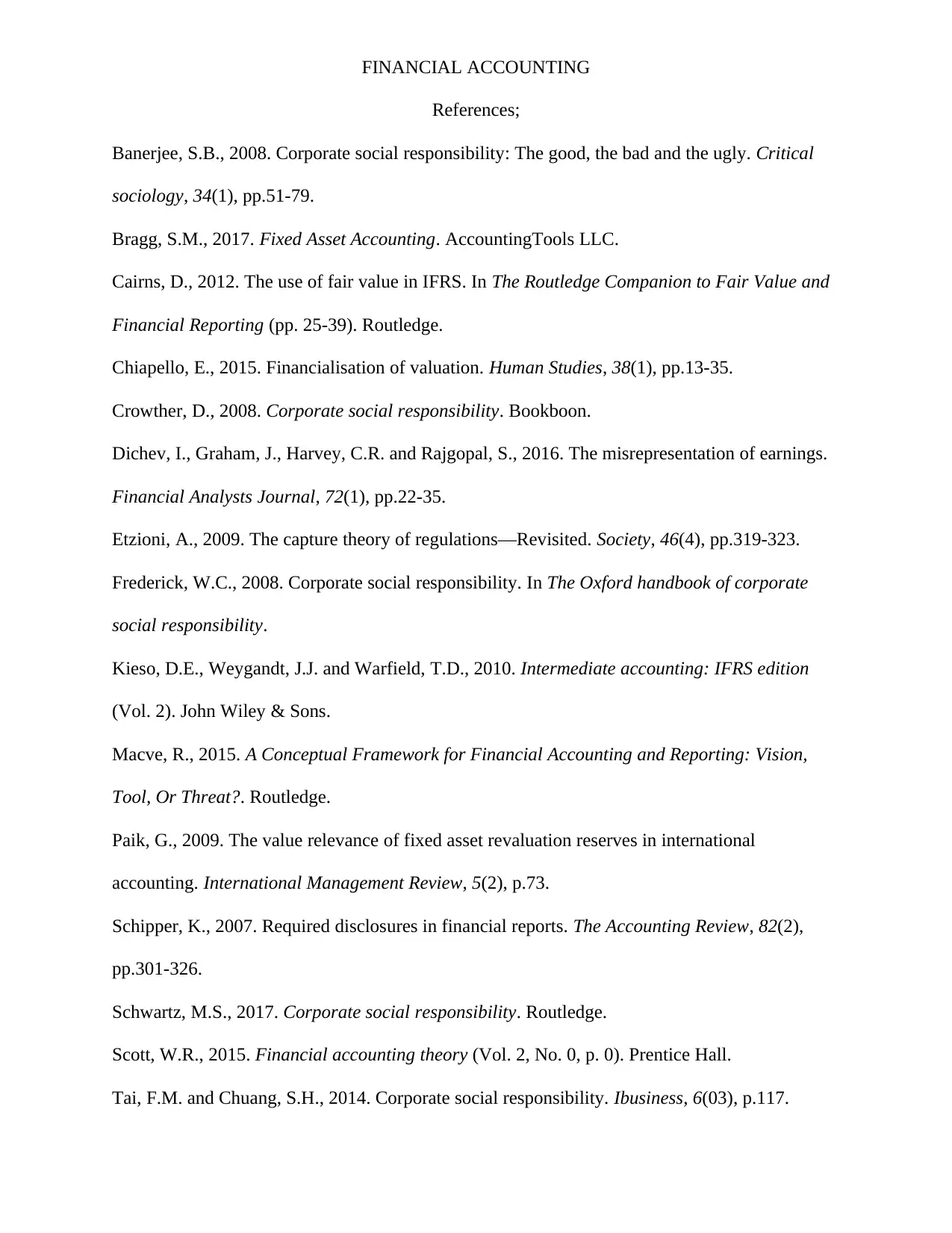
FINANCIAL ACCOUNTING
References;
Banerjee, S.B., 2008. Corporate social responsibility: The good, the bad and the ugly. Critical
sociology, 34(1), pp.51-79.
Bragg, S.M., 2017. Fixed Asset Accounting. AccountingTools LLC.
Cairns, D., 2012. The use of fair value in IFRS. In The Routledge Companion to Fair Value and
Financial Reporting (pp. 25-39). Routledge.
Chiapello, E., 2015. Financialisation of valuation. Human Studies, 38(1), pp.13-35.
Crowther, D., 2008. Corporate social responsibility. Bookboon.
Dichev, I., Graham, J., Harvey, C.R. and Rajgopal, S., 2016. The misrepresentation of earnings.
Financial Analysts Journal, 72(1), pp.22-35.
Etzioni, A., 2009. The capture theory of regulations—Revisited. Society, 46(4), pp.319-323.
Frederick, W.C., 2008. Corporate social responsibility. In The Oxford handbook of corporate
social responsibility.
Kieso, D.E., Weygandt, J.J. and Warfield, T.D., 2010. Intermediate accounting: IFRS edition
(Vol. 2). John Wiley & Sons.
Macve, R., 2015. A Conceptual Framework for Financial Accounting and Reporting: Vision,
Tool, Or Threat?. Routledge.
Paik, G., 2009. The value relevance of fixed asset revaluation reserves in international
accounting. International Management Review, 5(2), p.73.
Schipper, K., 2007. Required disclosures in financial reports. The Accounting Review, 82(2),
pp.301-326.
Schwartz, M.S., 2017. Corporate social responsibility. Routledge.
Scott, W.R., 2015. Financial accounting theory (Vol. 2, No. 0, p. 0). Prentice Hall.
Tai, F.M. and Chuang, S.H., 2014. Corporate social responsibility. Ibusiness, 6(03), p.117.
References;
Banerjee, S.B., 2008. Corporate social responsibility: The good, the bad and the ugly. Critical
sociology, 34(1), pp.51-79.
Bragg, S.M., 2017. Fixed Asset Accounting. AccountingTools LLC.
Cairns, D., 2012. The use of fair value in IFRS. In The Routledge Companion to Fair Value and
Financial Reporting (pp. 25-39). Routledge.
Chiapello, E., 2015. Financialisation of valuation. Human Studies, 38(1), pp.13-35.
Crowther, D., 2008. Corporate social responsibility. Bookboon.
Dichev, I., Graham, J., Harvey, C.R. and Rajgopal, S., 2016. The misrepresentation of earnings.
Financial Analysts Journal, 72(1), pp.22-35.
Etzioni, A., 2009. The capture theory of regulations—Revisited. Society, 46(4), pp.319-323.
Frederick, W.C., 2008. Corporate social responsibility. In The Oxford handbook of corporate
social responsibility.
Kieso, D.E., Weygandt, J.J. and Warfield, T.D., 2010. Intermediate accounting: IFRS edition
(Vol. 2). John Wiley & Sons.
Macve, R., 2015. A Conceptual Framework for Financial Accounting and Reporting: Vision,
Tool, Or Threat?. Routledge.
Paik, G., 2009. The value relevance of fixed asset revaluation reserves in international
accounting. International Management Review, 5(2), p.73.
Schipper, K., 2007. Required disclosures in financial reports. The Accounting Review, 82(2),
pp.301-326.
Schwartz, M.S., 2017. Corporate social responsibility. Routledge.
Scott, W.R., 2015. Financial accounting theory (Vol. 2, No. 0, p. 0). Prentice Hall.
Tai, F.M. and Chuang, S.H., 2014. Corporate social responsibility. Ibusiness, 6(03), p.117.
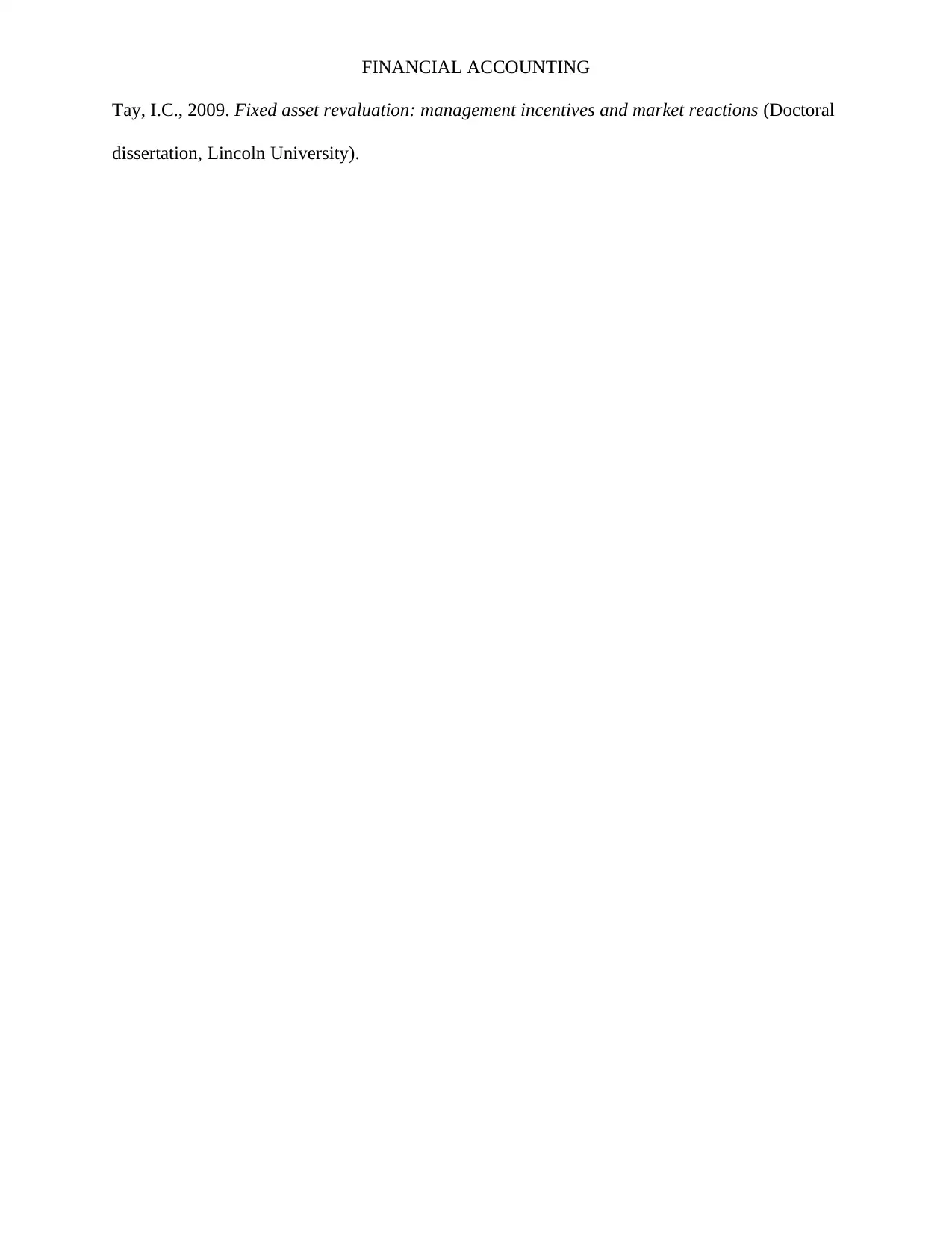
FINANCIAL ACCOUNTING
Tay, I.C., 2009. Fixed asset revaluation: management incentives and market reactions (Doctoral
dissertation, Lincoln University).
Tay, I.C., 2009. Fixed asset revaluation: management incentives and market reactions (Doctoral
dissertation, Lincoln University).
⊘ This is a preview!⊘
Do you want full access?
Subscribe today to unlock all pages.

Trusted by 1+ million students worldwide
1 out of 9
Related Documents
Your All-in-One AI-Powered Toolkit for Academic Success.
+13062052269
info@desklib.com
Available 24*7 on WhatsApp / Email
![[object Object]](/_next/static/media/star-bottom.7253800d.svg)
Unlock your academic potential
Copyright © 2020–2025 A2Z Services. All Rights Reserved. Developed and managed by ZUCOL.





